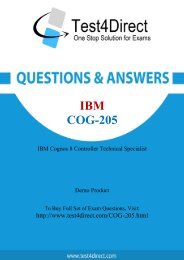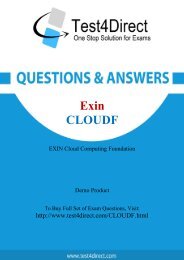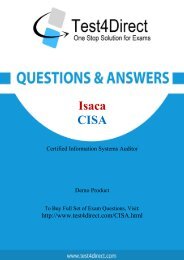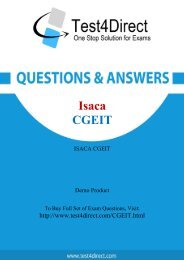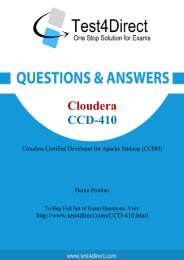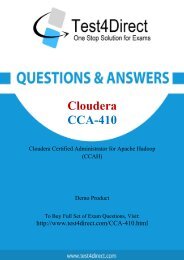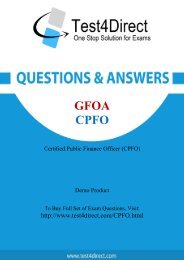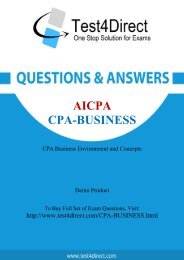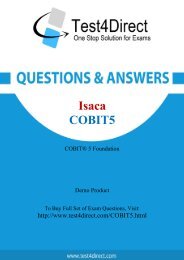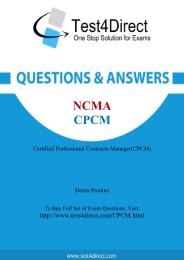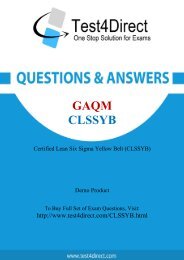CFA-Level-III Latest Exam BrainDumps
Test4Direct provides latest PDF questions of CFA Institute CFA-Level-III exam. You have an opportunity to pass the CFA Institute CFA-Level-III exam in one go. Test4Direct is most accurate source to prepare CFA Institute CFA-Level-III exam as your success will become site’s responsibility after purchasing CFA-Level-III exam product. There are also lots of discounts and promotion offers that you can avail. Let’s try a free demo http://www.test4direct.com/CFA-Level-III.html
Test4Direct provides latest PDF questions of CFA Institute CFA-Level-III exam. You have an opportunity to pass the CFA Institute CFA-Level-III exam in one go. Test4Direct is most accurate source to prepare CFA Institute CFA-Level-III exam as your success will become site’s responsibility after purchasing CFA-Level-III exam product. There are also lots of discounts and promotion offers that you can avail. Let’s try a free demo http://www.test4direct.com/CFA-Level-III.html
You also want an ePaper? Increase the reach of your titles
YUMPU automatically turns print PDFs into web optimized ePapers that Google loves.
<strong>CFA</strong> Institute<br />
<strong>CFA</strong>-LEVEL-<strong>III</strong><br />
<strong>CFA</strong> <strong>Level</strong> <strong>III</strong> Chartered Financial Analyst<br />
Demo Product<br />
To Buy Full Set of <strong>Exam</strong> Questions, Visit:<br />
http://www.test4direct.com/<strong>CFA</strong>-LEVEL-<strong>III</strong>.html
Question: 1<br />
HAS THREE PARTS FOR A TOTAL OF 23 MINUTES Aaron Bell, a portfolio manager, is focusing his<br />
attention on investment style, and whether style should be a factor in investment decision making.<br />
Bell decides to play it safe and investigate how he can use different instruments related to style<br />
indices or indexing strategies to see if he can add value to his customers’ portfolios.<br />
A. Explain holdings-based style analysis. Discuss one disadvantage of holdings-based style analysis<br />
and one advantage over returns-based style analysis.<br />
B. Explain returns-based style analysis. Reproduce the general form of the regression equation used<br />
for returns-based style analysis, including any constraints, and label each component of the<br />
equation. Discuss one disadvantage of returns-based style analysis and one advantage over holdingsbased<br />
style analysis.<br />
C. Bell is considering indexing strategies and a colleague has suggested three alternatives: full<br />
replication; stratified sampling; and optimization. Explain each along with the conditions under<br />
which each would be appropriate to use and provide one disadvantage for each.<br />
Question: 2<br />
Answer: A<br />
HAS THREE PARTS Wyatt Washington is the portfolio manager for Mark Beitia, a recent retiree. He is<br />
currently exploring a change in Beitia’s strategic asset allocation. He gathers data on the expected<br />
returns, standard deviations, and correlations for five assets. Using these market expectations, he<br />
derives an efficient frontier. Washington uses the following information in his construction of the<br />
asset allocation:<br />
• Beitia’s asset base = $5,000,000.<br />
• Annual after-tax spending amount = $150,000.<br />
• Estimate of future inflation = 3.5%.<br />
• Beitia will donate $750,000 to his alma mater in one year in one lump sum.<br />
• Risk-free rate = 4.0%.<br />
• Beitia’s income tax rate = 25%.<br />
Washington forms four corner portfolios from his efficient frontier and calculates the following<br />
expected returns and standard deviations:
A. Calculate the required before-tax return for Beitia’s portfolio and Beitia’s expected utility from<br />
holding each of the corner portfolios.<br />
B. Assuming that Washington combines two corner portfolios to meet Beitia’s desired return<br />
(calculated in Part A), calculate the weights of the appropriate corner portfolios that will be used<br />
(assume no borrowing or short-selling) and the resulting portfolio standard deviation.<br />
C. Assuming that Washington combines a corner portfolio with the risk-free asset to meet Beitia’s<br />
desired return (calculated in Part A), calculate the weights of the appropriate corner portfolio and<br />
the risk-free asset that will be used (assume no borrowing) and the resulting portfolio standard<br />
deviation.<br />
Question: 3<br />
Question: 4<br />
Answer: B<br />
HAS THREE PARTS One year has passed since HNW Advisors first started operations. Their overall<br />
equity portfolio has returned 28.2% versus a return of 22.4% for the S&P 500. The standard deviation<br />
of the S&P 500 is 20%, and Maggie Day, <strong>CFA</strong>, has estimated the standard deviation of HNW Advisor’s<br />
equity portfolio at 45%. HNW Advisor’s equity portfolio has a beta of 1.35, and the risk-free rate is<br />
4.4%. A major HNW client is attempting to evaluate the relative performance of HNW’s equity fund.<br />
The client is unsure whether the Sharpe measure or the Treynor measure is appropriate for the HNW<br />
portfolio.<br />
A. Using the Sharpe and Treynor measures for the HNW portfolio and the S&P 500, determine how<br />
HNW has performed relative to the S&P 500.<br />
B. Assume that, using the Sharpe ratio to measure performance, the S&P 500 outperformed the<br />
HNW portfolio, but using the Treynor measure, the HNW portfolio outperformed the S&P 500.<br />
Explain, in terms of systematic and unsystematic risk, how this change in ranking could have<br />
occurred.<br />
C. Compute M2 for the HNW portfolio, assuming management uses the market as a benchmark.<br />
Explain, in terms of relative returns and volatility, the circumstances under which M2 for HNW would<br />
equal M2 for the market.<br />
Answer: B<br />
HAS TWO PARTS Tom Groh is the President of Opportunity Banks. Opportunity has historically<br />
operated in the northeastern United States, with most of its business in Maryland, Delaware, and<br />
New Jersey. Opportunity has been in business since 1987 and has built its business on making<br />
mortgages and construction loans to residential developers. Opportunity has been very profitable,<br />
because developers value the services the bank provides. This allows Opportunity to price their<br />
construction loans with higher interest rates. Opportunity services and retains ownership of the its<br />
loans. It historically has had a near-zero leverage-adjusted duration gap. In the most recent fiscal<br />
year, Opportunity has experienced important changes in their business as follows:<br />
1. Due to pressure from local activists, Opportunity has stepped up lending in low-income areas.<br />
Groh expects the default rate on these loans to be higher than the Loans currently in their portfolio.<br />
2. Opportunity has bought a regional bank with operations in North Carolina, South Carolina, and
Georgia. The acquired bank’s loan portfolio consists mostly of commercial loans to small, local<br />
businesses.<br />
3. A recent downturn in interest rates has caused many of Opportunity’s variable rate mortgages to<br />
be refinanced to 15 and 30-year fixed-rate mortgages. Opportunity has retained the business of most<br />
of its customers who have refinanced.<br />
a. In each of the scenarios provided, determine one effect on the investment objectives, constraints,<br />
or investment policies of the bank’s security portfolio. Evaluate each scenario in isolation from the<br />
others.<br />
A. answer Question 10-A in the template provided.<br />
Question: 5<br />
Answer: A<br />
HAS ONE PART Bailey Investments is a U.S.-based investment management firm. They began<br />
operations on January 1, 2004. Their client base has grown considerably over the last few years and
in order to ensure accurate and consistent performance data they have decided to pursue GIPS®<br />
compliance. The following includes composite data and notes relating to the first presentation for<br />
one of their composites in which they claim GIPS compliance. Bailey Investments has prepared and<br />
presented this report in compliance with the Global Investment Performance Standards (GIPS®).<br />
Notes:<br />
1. Valuations are obtained by Reuters and computed using the U.S. dollar.<br />
2. Bailey Investments is a dedicated equity portfolio manager that invests entirely in U.S. securities<br />
and has no affiliates.<br />
3. The benchmark composition is 100% S&P 500. The annualized compound benchmark return is<br />
8.15%. The annualized compound composite return is 8.06%.<br />
4. Composite dispersion is the annualized monthly standard deviation of composite returns.<br />
5. No modifications to the composites as presented here have occurred as a result of changes in<br />
personnel or for any other reason at any time.<br />
6. Performance results are presented before management and custodial fees but after all trading<br />
commissions.<br />
7. The composite includes discretionary and non-discretionary fee-paying portfolios. ListJour<br />
noncompliant items in the presentation. For each, state the necessary corrective action.
A. Templete 4<br />
B. Templete of Question 8 in the template provied.<br />
Answer: B
THANKS FOR TRYING THE DEMO OF OUR PRODUCT<br />
Visit Our Site to Purchase the Full Set of Actual <strong>CFA</strong>-LEVEL-<strong>III</strong> <strong>Exam</strong> Questions With<br />
Answers.<br />
http://www.test4direct.com/<strong>CFA</strong>-LEVEL-<strong>III</strong>.html<br />
We Also Provide Practice <strong>Exam</strong> Software That Simulates Real <strong>Exam</strong> Environment And Has<br />
Many Self-Assessment Features. Download Free Product Demo From:<br />
http://www.test4direct.com/<strong>CFA</strong>-LEVEL-<strong>III</strong>.html<br />
Money Back Guarantee<br />
Check Out Our Customer Testimonials




